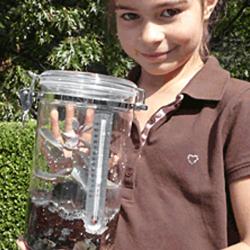Source Institutions
Source Institutions
Add to list Go to activity
Activity link broken? See if it's at the internet archive

In this activity, learners make a miniature greenhouse or "terrarium" to explore the greenhouse effect. Learners will first construct their model greenhouse using a clear, tall airtight container, potting soil, small plants, pebbles, and filtering charcoal. Then, learners will observe the terrarium closely for several days, record how the plants grow, and chart temperature readings inside and outside the container. Learners are encouraged to compare their findings with each other. This activity can be used to introduce learners to climate change issues.
- Under 5 minutes
- 1 to 7 days
- $1 - $5 per student
- Ages 8 - 18
- Activity, Experiment/Lab Activity, Model
- English
Quick Guide
Materials List (per student)
- 1 clear, tall, airtight container (such as a large empty plastic jar with a screw top or a glass canister with an sealed lid)
- potting soil
- small plants (such as mosses, ferns, philodendron, pothos, African violets)
- pebbles or broken flowerpot chips
- filtering charcoal (not barbecue charcoal)
- 2 small thermometers (about 4-5 inches long)
- paper towel or cloth
- water
Subjects
-
Earth and Space Science
-
Earth Processes
- Geochemical Cycles
- Weather and Climate
-
Earth Structure
- Atmosphere
- Earth, Moon and Sun
- Earth's History
-
Earth Processes
-
Life Sciences
-
Diversity of Life
- Plants
-
Ecology
- Energy Flow and Chemical Cycles
- Human Impact
-
Diversity of Life
-
Engineering and Technology
-
Engineering
- Environmental Engineering
-
Engineering
-
Mathematics
-
Data Analysis and Probability
- Data Analysis
- Data Collection
- Data Representation
- Measurement
-
Data Analysis and Probability
-
Physical Sciences
-
Heat and Thermodynamics
- Heat and Temperature
- Heat Transfer
- Energy
-
Heat and Thermodynamics
-
The Nature of Science
-
Science and Society
- Risks and Benefits
-
The Scientific Process
- Conducting Investigations
- Gathering Data
- Formulating Explanations
- Communicating Results
-
Science and Society
-
The Nature of Technology
-
Technology and Society
- Impacts of Technology
- Technology and the Environment
-
Technology and Society
Informal Categories
- Gardening
- Model Building
- Nature and Environment
Audience
To use this activity, learners need to:
- see
- read
- touch
Learning styles supported:
- Uses STEM to solve real-world problems
- Involves hands-on or lab activities
Other
Components that are part of this resource:
This resource is part of:
Access Rights:
- Free access
By:
Source Collection
- Ology
Rights:
- All rights reserved, American Museum of Natural History,
